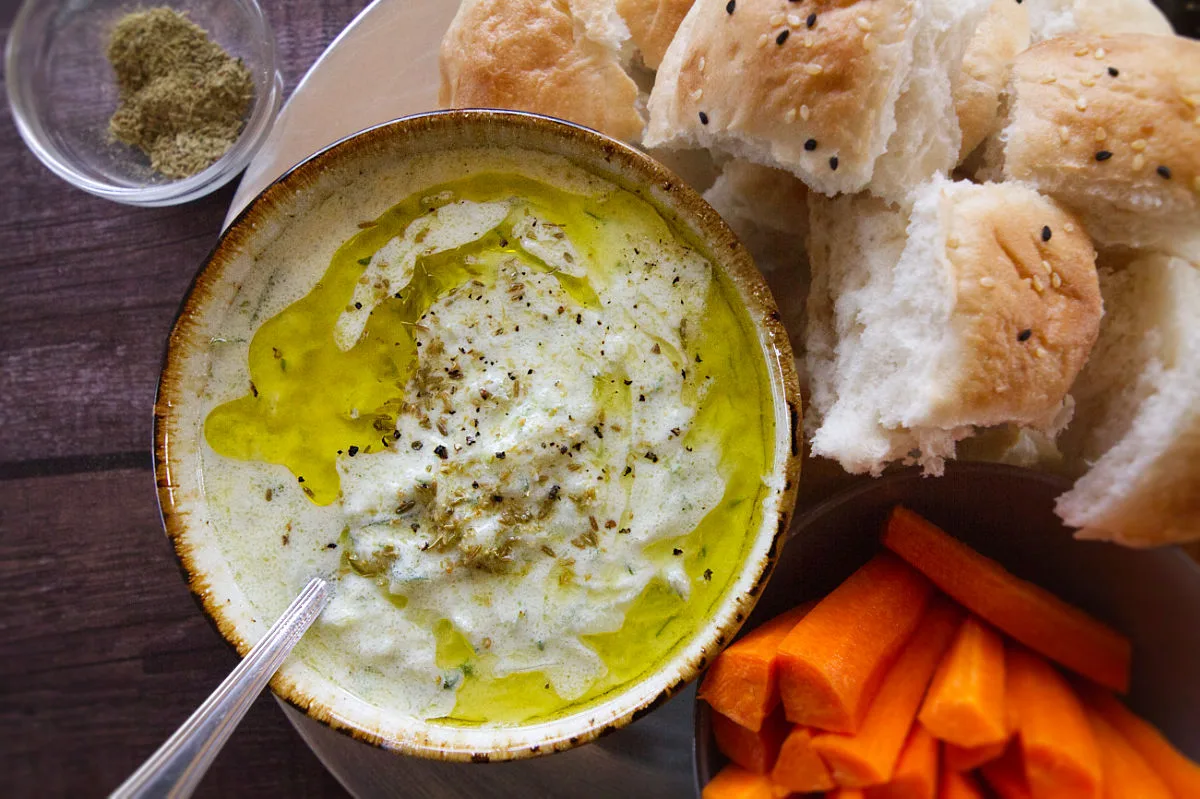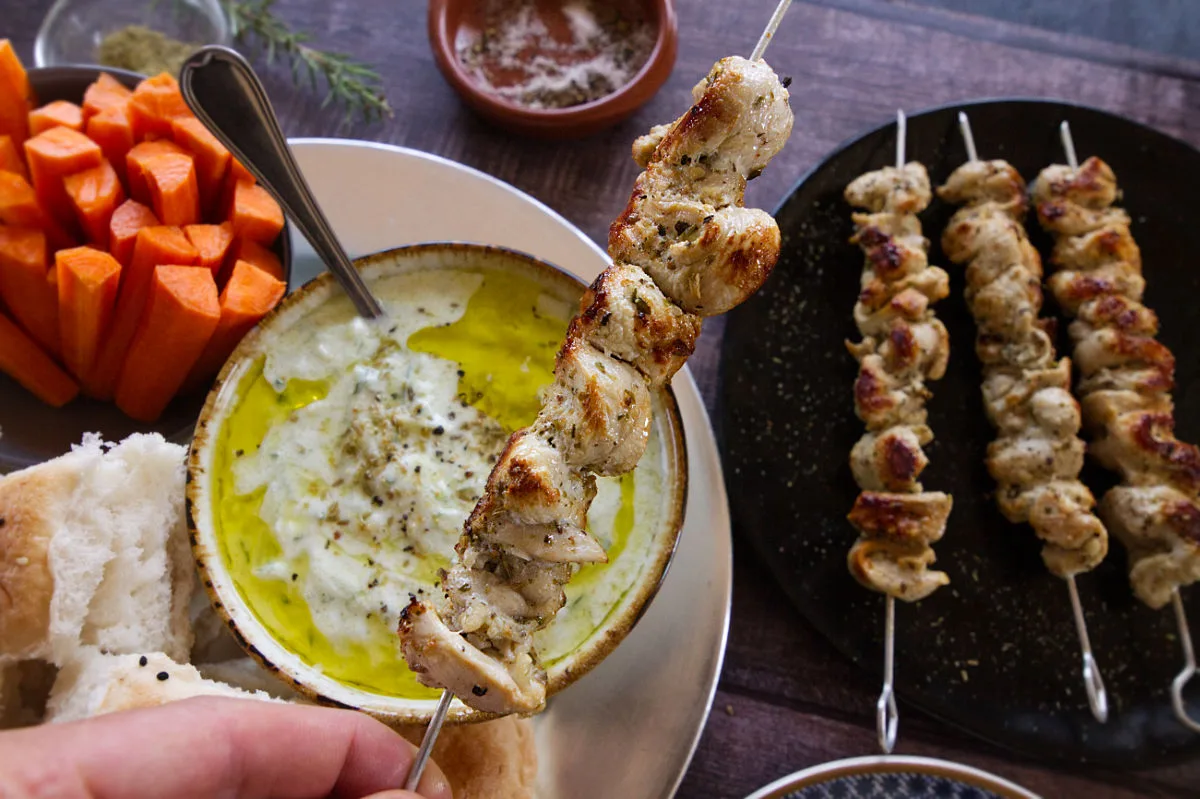Recreate the beauty and flavor of an authentic Greek meze plate at home that will impress at your next gathering! This article is dedicated to everything that you’ll typically find on a meze plate in Greece. We’ll look at what to use to make an authentic Greek Meze platter, including what ingredients are commonly used, plus earmark a few classic Greek recipes that all go together to recreate the ultimate Greek Meze platter experience.
Table of Contents:
- What is a Greek meze?
- What are the most common items used in a Greek meze platter?
- When to serve or order Greek meze
- Cultural significance of Greek meze
- Why not make your own meze at home?
What is a Greek meze?
A Greek meze platter typically consists of a variety of small, flavorful dishes served as appetizers or snacks. These dishes showcase the rich and diverse flavors of Greek cuisine and are a great way to enjoy a leisurely meal or snack with your family or friends.
While the popularity of specific ingredients can vary from region to region and personal preferences, there are some common favorites that you’ll see served on meze platters in Greece.
What are the most common items used in a Greek meze platter?
Some of the most common and popular ingredients found on a Greek meze platter include:
- Olives: Greek olives are a staple on any meze platter, and they come in various varieties and flavors so choose your favorite or a combination to try.
- Feta cheese: This famous Greek cheese made from sheep’s milk is often served with olives and tomatoes or just drizzled with olive oil.
- Tzatziki: A creamy yogurt-based dip made with cucumber, garlic, and fresh fennel, dill, or mint. Check out our easy 10-minute creamy Greek tzatziki recipe so you can make your own.
- Hummus: While not originally Greek, hummus has become a popular addition to Greek meze plates. It’s a chickpea-based dip often flavored with tahini and lemon juice.
- Dolmades: Stuffed grape leaves filled with rice, herbs, and sometimes minced meat.
- Taramasalata: A fish roe dip, usually made from carp or cod roe, blended with olive oil, lemon juice, and bread crumbs. This has a very strong fish aroma and taste so it’s great for seafood lovers.
- Spanakopita: A savory pastry filled with spinach, feta cheese, onions, and herbs. Yum!
- Tyropita: Another delicious Greek pastry, this one is filled with a mixture of cheeses like feta and ricotta.
- Greek Meatballs (Keftedes): Flavored with herbs and often served with tzatziki.
- Grilled vegetables: Commonly featuring eggplant, zucchini, bell peppers, and tomatoes, then drizzled with olive oil and sprinkled with herbs.
- Melitzanosalata: An eggplant dip similar to baba ganoush.
- Greek Sausages (Loukaniko): Spiced pork or lamb sausages that are often grilled.
- Saganaki: Fried cheese, typically made with halloumi or kefalotyri cheese and sometimes flambéed with brandy.
- Calamari: Fried or grilled squid rings.
- Pita bread: Nearly always served alongside the meze dishes to scoop up the dips and bites.
These are just a few examples, and the actual composition of a Greek meze plate can vary widely depending on the chef or the occasion. Meze is all about sharing and enjoying a wide range of flavors, so there’s plenty of room for creativity and variation.

When to serve or order Greek meze
There’s no wrong time to serve Greek meze! It’s a versatile and popular way of dining that can be served on various occasions. Here are some common instances when a Greek meze plate is typically served:
Social gatherings
Meze is perfect for social gatherings, such as parties, family reunions, and gatherings with friends. Its communal nature encourages sharing and creates a relaxed and fun atmosphere, making it ideal for socializing as your friends can move around the room and sample the different dishes.
Festive occasions
Meze is often served during festive celebrations, such as holidays like Christmas and Easter, or during local festivals and special events. It adds a touch of tradition and excitement to the festivities.
Pre-dinner appetizers
In Greek dining culture, meze can be served as a prelude to the main course. If you’re having a dinner party, offering a meze plate before the main meal lets your guests enjoy a variety of flavors while waiting for the main dishes to be prepared. It’s also great if you want people to mingle as it’s typically finger food so people don’t have to be bound to their spot at the table.
Outdoor picnics
Meze is a fantastic option for picnics or beach outings. Since it’s just a collection of small dishes it’s easy to transport and share, making it a popular choice for enjoying a meal in nature. Plus, many of the dishes can be enjoyed cold.
Casual dining
Meze is often served in tavernas and casual eateries throughout Greece and it’s made its way to many bars and restaurants overseas. It’s a great option if you’re looking for a lighter, more varied meal or for foodies who prefer to sample a range of flavors rather than committing to a single large dish.
Wine and ouzo tastings
Meze pairs well with Greek wines and the traditional Greek spirit, ouzo. During wine tastings or when enjoying ouzo with friends, meze complements the drinks.
Appetizers at a restaurant
When dining out at a Greek restaurant, you might find a meze platter listed on the menu as an appetizer or starter option. It’s an excellent way to begin a meal slowly and get a taste of different Greek delicacies.
Ultimately, the versatility of a Greek meze plate makes it suitable for many occasions. The fact that it is all about sharing and celebrating Greek food traditions makes it popular among Greeks and visitors.
Cultural significance of Greek meze
The Greek Meze isn’t only about food — it holds significant cultural importance in Greek society and dining traditions.
Social and communal aspect
Meze is more than just a style of eating; it represents a way of socializing and building connections among friends and family. Greeks value their mealtime gatherings as opportunities to share stories, exchange ideas, and strengthen bonds. Meze encourages a relaxed and fun atmosphere, as people share small dishes and chat and catch up.
Culinary heritage
Meze showcases the rich culinary heritage of Greece. It reflects the country’s diverse flavors, traditional recipes, and locally sourced ingredients. Each region might have its unique meze dishes, highlighting the regional specialties and eating what’s in season.
Symbol of hospitality
Offering meze to guests is a symbol of Greek hospitality. It demonstrates the host’s generosity and willingness to share their best dishes with visitors. Greeks take pride in preparing delicious and overflowing meze platters to make everyone feel welcome and cared for.
Balanced eating
Meze encourages a balanced way of eating. Instead of focusing on a single large main course, the variety of small dishes means a more diverse and nutrient-rich meal. This approach aligns with the Mediterranean diet, which is renowned for its health benefits.
Historical roots
The concept of meze has deep historical roots in Greece. Similar styles of communal dining have been practiced for centuries across the Mediterranean and the Middle East. It reflects the region’s history of trade, cultural exchange, and love of food.
Leisurely dining
Meze is usually associated with leisurely dining experiences, where you take time to savor each dish, enjoy good company, and appreciate the simple pleasures of life. This leisurely pace contrasts with the rushed or hurried eating style we often experience like grabbing a sandwich and eating it in a few minutes.
Celebration of flavors
Greek meze allows people to celebrate the distinct and harmonious flavors of Greek cuisine. The combination of various tastes, from savory to tangy to sweet, creates an exciting and memorable experience for your taste buds. After all, variety is the spice of life.
Why not make your own meze at home?
If that all sounds pretty special to you, why not invite some friends and family around and make your own Greek meze platter and live the experience? Just pick and choose the dishes you want to try and prepare them, put on some music, and enjoy the dishes as you catch up with your friends or family.


Leave a Reply